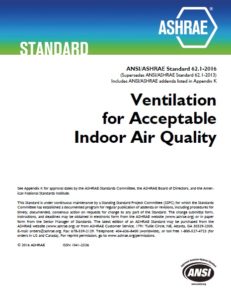ANSI/ASHRAE Standard 62.1 Ventilation for Acceptable Indoor Air Quality 2016
ANSI/ASHRAE Standard 62.1 Ventilation for Acceptable Indoor Air Quality 2016
ANSI/ASHRAE Standard 62.1 Ventilation for Acceptable Indoor Air Quality-2016.First published in 1973 as Standard 62, Standard 62.1 specifies minimum ventilation rates and other measures for new and existing buildings that are intended to provide indoor air quality that is acceptable to human occupants and that minimizes adverse health effects.
Whereas changes to the 2013 edition of the standard primarily focused on usability and clarity, the 2016 edition includes a major change to the scope of the standard by which residential occupancies are moved from Standard 62.1 to Standard 62.2. Dwelling units are now addressed in Standard 62.2, regardless of building height, while common areas are addressed by Standard 62.1. Other changes to the 2016 edition include the following:
- A revised definition of “environmental tobacco smoke” (ETS) to include emissions from electronic smoking devices and also the smoking of cannabis
- Revised operations and maintenance requirements to better align Standard 62.1 with the requirements in ASHRAE/ACCA Standard 180-2012
- New requirements to the Indoor Air Quality Procedure for determining minimum ventilation rates by considering the combined effects of multiple contaminants of concern on individual organ systems
- A change to explicitly allow environmental health and safety professionals to determine whether a lower air class is appropriate for a particular laboratory exhaust system
You can also Read ANSI/ASHRAE Standard 62.2-2016 Edition Ventilation and Acceptable Indoor Air Quality in Residential Buildings
ANSI/ASHRAE Standard 62.1 Ventilation for Acceptable Indoor Air Quality-2016
- Scope
![ANSI/ASHRAE Standard 62.1 ASHRAE Standard 62.1,ASHRAE,Standard 62.1, HVAC,Indoor Air Quality,Ventilation]()
- Definitions
- Outdoor Air Quality
- Systems and Equipment
- Procedures
- Construction and System Start-Up
- Operations and Maintenance
- References
- A: Multiple-Zone Systems
- B: Separation of Exhaust Outlets and Outdoor Air Intakes
- C: Summary of Selected Air Quality Guidelines
- D: Rationale for Minimum Physiological Requirements for Respiration Air Based on CO2 Concentration
- E: Acceptable Mass Balance Equations for Use with the IAQ Procedure
- F: Information on Selected National Standards and Guidelines for PM10, PM2.5, and Ozone
- G: Application and Compliance
- H: Documentation
- I: National Ambient Air Quality Standards (NAAQS)
- J: Informative References.
- K: Addenda Description Information


Comments are closed.